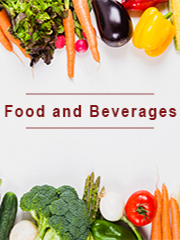Report overview
Vegetable protein refers to the proteins extracted from plants like soybean, wheat, rice, pea, etc. The protein is an important component of human cells, consisting of monomers called amino acids. Vegetable protein is an alternative to animal protein and it can be absorbed easily. Protein is important to human body. Most people require about 0.8 grams of protein per kilogram of body weight, or about 58 grams of protein per day for a 160-pound adult.
The difference between the animal protein and vegetable protein lies in the amino acid content. Animal proteins are called complete proteins because they contain all essential amino acids. Animal protein has the amino acids that the body is unable to synthesize and must be included in the diet to allow for the proper conduct of protein synthesis. Vegetable protein composition does not provide all the amino acids. Unlike animal proteins, vegetable proteins are low in fat and produce nitrogenous waste, which is the waste products of proteins, which should be less harmful to avoid overloading the kidneys.
This report aims to provide a comprehensive presentation of the global market for Vegetable Protein, with both quantitative and qualitative analysis, to help readers develop business/growth strategies, assess the market competitive situation, analyze their position in the current marketplace, and make informed business decisions regarding Vegetable Protein. This report contains market size and forecasts of Vegetable Protein in global, including the following market information:
Global Vegetable Protein Market Revenue, 2018-2023, 2024-2029, ($ millions)
Global Vegetable Protein Market Sales, 2018-2023, 2024-2029, (Ton)
Global top five Vegetable Protein companies in 2022 (%)
The global Vegetable Protein market was valued at US$ 14900 million in 2022 and is projected to reach US$ 30940 million by 2029, at a CAGR of 11.0% during the forecast period. The influence of COVID-19 and the Russia-Ukraine War were considered while estimating market sizes.
Global Vegetable Protein key players include Danisco(DuPont), ADM, CHS, Manildra Group, Gushen Biological, etc. Global top five manufacturers hold a share over 30%.
China is the largest market, with a share over 35%, followed by North America and Europe, both have a share about 50%.
In terms of product, Wheat Protein is the largest segment, with a share over 40%. And in terms of application, the largest application is Feed, followed by Bakery Food Ingredients, Nutrition Health Care Products, etc.
We surveyed the Vegetable Protein manufacturers, suppliers, distributors and industry experts on this industry, involving the sales, revenue, demand, price change, product type, recent development and plan, industry trends, drivers, challenges, obstacles, and potential risks.
Total Market by Segment:
Global Vegetable Protein Market, by Type, 2018-2023, 2024-2029 ($ Millions) & (Ton)
Global Vegetable Protein Market Segment Percentages, by Type, 2022 (%)
Wheat Protein
Soy Protein Concentrate
Soy Protein Isolate
Textured Soy Protein
Pea Protein
Global Vegetable Protein Market, by Application, 2018-2023, 2024-2029 ($ Millions) & (Ton)
Global Vegetable Protein Market Segment Percentages, by Application, 2022 (%)
Feed
Bakery Food Ingredients
Nutrition Health Care Products
Meat Substitutes
Beverage
Others
Global Vegetable Protein Market, By Region and Country, 2018-2023, 2024-2029 ($ Millions) & (Ton)
Global Vegetable Protein Market Segment Percentages, By Region and Country, 2022 (%)
North America
US
Canada
Mexico
Europe
Germany
France
U.K.
Italy
Russia
Nordic Countries
Benelux
Rest of Europe
Asia
China
Japan
South Korea
Southeast Asia
India
Rest of Asia
South America
Brazil
Argentina
Rest of South America
Middle East & Africa
Turkey
Israel
Saudi Arabia
UAE
Rest of Middle East & Africa
Competitor Analysis
The report also provides analysis of leading market participants including:
Key companies Vegetable Protein revenues in global market, 2018-2023 (Estimated), ($ millions)
Key companies Vegetable Protein revenues share in global market, 2022 (%)
Key companies Vegetable Protein sales in global market, 2018-2023 (Estimated), (Ton)
Key companies Vegetable Protein sales share in global market, 2022 (%)
Further, the report presents profiles of competitors in the market, key players include:
DuPont
ADM
CHS
Manildra Group
Roquette
Midwest Grain
CropEnergies
Tereos Syral
Showa Sangyo
Fuji Oil
Cargill
Cosucra
Nisshin Oillio
Tate & Lyle
World Food Processing
Topagri
Gushen Biological
Shansong Biological
Tianguan
Yuwang Group
Scents Holdings
Chinalotus
Goldensea Industry
Sinoglory Health Food
Shuangta Food
Harbin Hi-tech Soybean
Fiber Source Biological Engineering
Oriental Protein Tech
Wonderful Industrial Group
Tianjing Plant Albumen
Outline of Major Chapters:
Chapter 1: Introduces the definition of Vegetable Protein, market overview.
Chapter 2: Global Vegetable Protein market size in revenue and volume.
Chapter 3: Detailed analysis of Vegetable Protein manufacturers competitive landscape, price, sales and revenue market share, latest development plan, merger, and acquisition information, etc.
Chapter 4: Provides the analysis of various market segments by type, covering the market size and development potential of each market segment, to help readers find the blue ocean market in different market segments.
Chapter 5: Provides the analysis of various market segments by application, covering the market size and development potential of each market segment, to help readers find the blue ocean market in different downstream markets.
Chapter 6: Sales of Vegetable Protein in regional level and country level. It provides a quantitative analysis of the market size and development potential of each region and its main countries and introduces the market development, future development prospects, market space of each country in the world.
Chapter 7: Provides profiles of key players, introducing the basic situation of the main companies in the market in detail, including product sales, revenue, price, gross margin, product introduction, recent development, etc.
Chapter 8: Global Vegetable Protein capacity by region & country.
Chapter 9: Introduces the market dynamics, latest developments of the market, the driving factors and restrictive factors of the market, the challenges and risks faced by manufacturers in the industry, and the analysis of relevant policies in the industry.
Chapter 10: Analysis of industrial chain, including the upstream and downstream of the industry.
Chapter 11: The main points and conclusions of the report.
